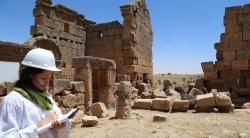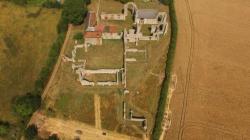INSTITUT SUPERIEUR D'ANTHROPOLOGIE
INSTITUTE OF ANTHROPOLOGY
ONLINE COURSES / COURS A DISTANCE
FALL TERM : OCTOBER 2015
REGISTER NOW
TURQUIE –  Diyarbakır - Excavations at the ancient Roman military outpost of Zerzevan Castle in the Çınar district of Turkey’s southeastern province of Diyarbakır have uncovered a chapel belonging to the very first Romans who converted to Christianity. “We can say it’s the first place of worship from when the Romans transitioned from polytheism to Christianity, ” Dicle University Archeology Faculty Assistant Professor Aytaç Coşkun said referring to the recently uncovered underground chapel in Diyarbakır’s Zerzevan Castle. Pointing out that they discovered several crosses as well as Aramaic script on the chapel’s walls, Coşkun says they have invited an Aramaic expert to decipher the writing. “It seems they also made a baptismal pool out of the parent rock,” Coşkun added. “It is a rather large baptismal pool. Since the first converts to Christianity were older, they built a large baptismal pool outside.” “This chapel was built when the number of Christian converts rose,” he said. “A larger church where soldiers and civilians could all worship was built on the same spot about 150 years later.” The archaeological study of Zerzevan Castle, once a military outpost used by the Roman Empire, began last year with a team of 35 but has since nearly doubled to 60 people. Started by the Turkish Ministry of Culture and Tourism, the Diyarbakır Governor’s Office, Dicle University and the District Governor’s Office, the excavations are expected to take at least 30 years. Located 13 kilometers from the town of Çınar, Zerzevan Castle’s wall remnants stretch 1,200 meters (4,000 feet), rise 12 meters (40 feet) in height and are spread out over a 60,000 square meter (645,835 square feet) area. The excavation has uncovered not just the chapel, but a 22 meter (72 foot) tall watchtower, barracks, baths, an armory, grain stores, administrative buildings, rock tombs and 54 cisterns. Coşkun notes that soldiers would have lived in the outpost with their families and would have housed around a thousand people comprised of both military personnel and civilians. “The castle occupies a strategic spot between the ancient cities of Dara and Amida, today’s Diyarbakır,” he said. “Its strategic position and its ability to control the ancient road passing through the area meant it was the first point a foreign army would reach before Amida. It’s clear there were many great battles here.” He adds that it was still in use till 639 C.E. when the armies of Islam spread throughout the region
Diyarbakır - Excavations at the ancient Roman military outpost of Zerzevan Castle in the Çınar district of Turkey’s southeastern province of Diyarbakır have uncovered a chapel belonging to the very first Romans who converted to Christianity. “We can say it’s the first place of worship from when the Romans transitioned from polytheism to Christianity, ” Dicle University Archeology Faculty Assistant Professor Aytaç Coşkun said referring to the recently uncovered underground chapel in Diyarbakır’s Zerzevan Castle. Pointing out that they discovered several crosses as well as Aramaic script on the chapel’s walls, Coşkun says they have invited an Aramaic expert to decipher the writing. “It seems they also made a baptismal pool out of the parent rock,” Coşkun added. “It is a rather large baptismal pool. Since the first converts to Christianity were older, they built a large baptismal pool outside.” “This chapel was built when the number of Christian converts rose,” he said. “A larger church where soldiers and civilians could all worship was built on the same spot about 150 years later.” The archaeological study of Zerzevan Castle, once a military outpost used by the Roman Empire, began last year with a team of 35 but has since nearly doubled to 60 people. Started by the Turkish Ministry of Culture and Tourism, the Diyarbakır Governor’s Office, Dicle University and the District Governor’s Office, the excavations are expected to take at least 30 years. Located 13 kilometers from the town of Çınar, Zerzevan Castle’s wall remnants stretch 1,200 meters (4,000 feet), rise 12 meters (40 feet) in height and are spread out over a 60,000 square meter (645,835 square feet) area. The excavation has uncovered not just the chapel, but a 22 meter (72 foot) tall watchtower, barracks, baths, an armory, grain stores, administrative buildings, rock tombs and 54 cisterns. Coşkun notes that soldiers would have lived in the outpost with their families and would have housed around a thousand people comprised of both military personnel and civilians. “The castle occupies a strategic spot between the ancient cities of Dara and Amida, today’s Diyarbakır,” he said. “Its strategic position and its ability to control the ancient road passing through the area meant it was the first point a foreign army would reach before Amida. It’s clear there were many great battles here.” He adds that it was still in use till 639 C.E. when the armies of Islam spread throughout the region
http://arts-entertainment.bgnnews.com/roman-christians-first-church-found-in-diyarbakir-southeast-turkey-haberi/9153?
ROYAUME UNI –  Leiston Abbey - Archaeologists believe they have found the remains of a hospital in the grounds of a ruined abbey on the Suffolk coast. The archaeology company has found what it believes to be the foundations of an infirmary in a farmer's field neighbouring the site. The abbey was founded by the Roman Catholic Premonstratensian order at nearby Minsmere in 1182 before moving to Leiston in 1363. It was suppressed in 1536 during Henry VIII's dissolution of the monasteries.
Leiston Abbey - Archaeologists believe they have found the remains of a hospital in the grounds of a ruined abbey on the Suffolk coast. The archaeology company has found what it believes to be the foundations of an infirmary in a farmer's field neighbouring the site. The abbey was founded by the Roman Catholic Premonstratensian order at nearby Minsmere in 1182 before moving to Leiston in 1363. It was suppressed in 1536 during Henry VIII's dissolution of the monasteries.
http://www.bbc.co.uk/news/uk-england-suffolk-34157573